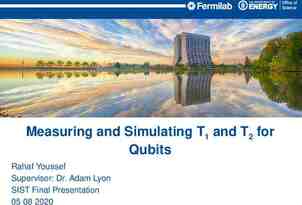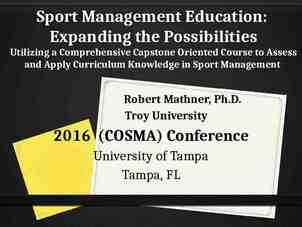City of Fresno CA1010007 Fresno County Jar Test Actiflo by Guy Schott,
18 Slides1.45 MB

City of Fresno CA1010007 Fresno County Jar Test Actiflo by Guy Schott, P.E. January 7, 2020

Kings River

City of Fresno Kings River Water Characteristics January 7, 2020 Source Turbidity: 0.45 NTU pH: 7.32 UVT: 91.7% (unfiltered) UVA/cm: 0.038

Actiflo Microsand Ballasted Clarification Treatment Alum

UVT/UVA UV transmittance (UVT) is a measurement of the amount of ultraviolet light (commonly at 254 nm due to its germicidal effect) that passes through a water sample compared to the amount of light that passes through a pure water sample. The measurement is expressed as a percentage, % UVT. %UVT 10(-UVA) x 100% UV absorbance (UVA) is calculated as a relative measure of the amount of light absorbed by a water sample compared with the amount of light absorbed by a pure water sample. UVA -log(%UVT/100)

Coagulant Used for Jar Testing Pro Pac 9800 (NTU Technologies) 50% Aluminum Chlorohydrate (ACH) 50% Water SG 1.34 Aluminum Sulfate 48.24% Aluminum Sulfate 8.2% Al2O3 SG 1.34 Nalco – Optimer 8110 PULV Polyacrylamide Dry Max use 1 mg/L

Laboratory Charge Analyzer LCA: Used to determine coagulant demand of a source water entering the treatment plant. Source pH: 7.32 LCA #1: Optimer 8110: 0.06 mg/L as product Alum: 6.29 mg/L as product pH adjusted to 6.8 with acetic acid.

City of Fresno – Northeast Plant, Jar Test 1-8 Results Flash Mix 200 RPM (30 sec), MR (Maturation) Jar # Alum mg/L J1 J2 J3 J4 J5 J6 J7 J8 6 8 10 12 12 14 16 18 110 RPM Mix min 2 2 2 2 2 2 2 2 Ballast Sand 8110 PULV mg/L ½ Tsp ½ Tsp ½ Tsp ½ Tsp ½ Tsp ½ Tsp ½ Tsp ½ Tsp 0.06 0.06 0.06 0.06 0.06 0.06 0.06 0.06 60 RPM MR min 3 3 3 3 3 3 3 3 Filtrate Filtrate Filtrate Settle NTU %UVT UVA/cm NTU 5 min 0.15 0.09 0.08 0.08 0.08 0.07 0.06 0.10 95.1 95.8 96.1 96.3 96.3 96.3 96.9 96.7 0.021 0.019 0.017 0.016 0.016 0.016 0.014 0.015 1.0 0.81 0.82 0.96 0.74 0.74 0.76 0.76

City of Fresno – Northeast Plant, Jar Test 9-16 Results Flash Mix 200 RPM (30 sec), MR (Maturation) Jar # Alum mg/L J9 J10 J11 J12 J13 J14 J15 J16 12 14 16 18 12 14 16 18 110 RPM Mix min 2 2 2 2 2 2 2 2 Ballast Sand 8110 PULV mg/L ½ Tsp ½ Tsp ½ Tsp ½ Tsp ½ Tsp ½ Tsp ½ Tsp ½ Tsp 1.0 1.0 1.0 1.0 0 0 0 0 60 RPM MR min 3 3 3 3 3 3 3 3 Filtrate Filtrate Filtrate Settle NTU %UVT UVA/cm NTU 5 min 0.08 0.07 0.06 0.10 0.12 0.09 0.13 0.10 96.3 96.7 96.7 96.6 96.1 96.2 96.0 96.3 0.016 0.015 0.015 0.015 0.017 0.017 0.018 0.016 0.77 0.89 0.75 0.65 0.71 1.07 0.78 0.66

City of Fresno – Northeast Plant, Jar Test 17-24 Results Flash Mix 200 RPM (30 sec), MR (Maturation) Jar # Alum mg/L J17 J18 J19 J20 J21 J22 J23 J24 12 14 16 18 12 14 16 18 110 RPM Mix min 2 2 2 2 2 2 2 2 Ballast Sand 8110 PULV mg/L 0 0 0 0 1/4 Tsp Tsp 1/4 Tsp 1/4 Tsp 0.06 0.06 0.06 0.06 0.06 0.06 0.06 0.06 60 RPM MR min 3 3 3 3 3 3 3 3 Filtrate Filtrate Filtrate Settle NTU %UVT UVA/cm NTU 5 min 0.12 0.11 0.11 0.09 0.12 0.11 0.08 0.08 96.2 96.4 96.8 96.7 96.4 96.4 96.5 96.7 0.017 0.016 0.014 0.015 0.016 0.016 0.015 0.015 0.63 0.65 0.63 0.57 0.74 0.72 0.87 0.79

City of Fresno – Northeast Plant, Jar Test 25-28 Results Flash Mix 200 RPM (30 sec), MR (Maturation) Jar # 9800 mg/L J25 J26 J27 J28 7.0 8.5 10 11.5 110 RPM Mix min 2 2 2 2 Ballast Sand 8110 PULV mg/L ½ Tsp ½ Tsp ½ Tsp ½ Tsp 0.06 0.06 0.06 0.06 60 RPM MR min 3 3 3 3 Filtrate Filtrate Filtrate Settle NTU %UVT UVA/cm NTU 5 min 0.08 0.11 0.10 0.10 96.4 96.4 96.6 96.7 0.016 0.016 0.015 0.015 0.73 0.72 0.80 0.62

Jar Testing – Procedures for Actiflo 1-Liter Jars 1. 2. 3. 4. 5. 6. 7. 8. Fill jars with source water prior to coagulant injection; set paddle speed at 30 rpm Add primary coagulant to each jar Flash mix for 15-60 seconds (200 rpm for 1-liter jars) Reduce paddled speed to (110 rpm for 1-liter jars) Add ballast sand (1/2 tsp/liter) Hold paddle speed for 2-minutes Reduce paddle speed to (60 rpm for 1-liter jars) Add polymer

Jar Testing – Procedures for Actiflo 1-Liter Jars - continue 1. 2. 3. 4. 5. 6. 7. Hold paddle speed for 3-minutes (maturation basin) Turn paddles off; raise paddles out of water; settled for 1 minute Syringe 25 mL from each jar taken 1-inch below surface (25 mL/12 sec rate) Filtered through 1.2 um Isopore membrane into cuvette (drip rate, 15 mL/90 sec) Measure filtrate turbidity, chlorine residual and %UVT or UVA Measure settled water turbidity after 5 minutes of total setting Record all data

Jar Test Filterability Test Equipment Turbidity Instrument Syringe w/Luer-Lock Tip, 30 cc (part#: 2225800, by Hach) Swinnex Filter Holder, 25 mm (part#: SX0002500) Isopore Membrane Filter, 1.2 um absolute pore size, Φ 25 mm , thickness: 24 um, hydrophilic polycarbonate membrane (part #: RTTP02500) Go to Sigma-Aldrich for laboratory supplies http://www.sigmaaldrich.com/united-states.html

Isopore Membrane Information Categories trade name filter color chemistry water flow rate media wettability porosity pore size bubble point at 23 C thickness filter diameter (ø) material size Information Isopore White Polycarbonate (PC) Avg. 175 mL/min x cm² (typical results @ 10 psi) Isopore Hydrophilic 14.7% 1.2 µm 1.0 bar, air with water 24 µm 25 mm polycarbonate, Hydrophilic, 1.2 µm, 25 mm, white, plain, 100

Isopore Membrane Background Information The Isopore membrane is a polycarbonate, track-etched screen filter recommended for all analyses in which the sample is viewed on the surface of the membrane. The Isopore membrane is composed of polycarbonate film, which has a smooth, glass-like surface for clearer sample observation. The unique manufacturing process of the membrane ensures a precise pore diameter and a consistent pore size for accurate separation of samples by size. Matched-weight filters are not usually required because of low, constant tar and ash weights. Features & Benefits: Membrane structure retains particles on the surface, simplifying counting and analysis

Jar Test - Filterability Test Syringe 25 mL from jar (after 5-minutes of settling) Filter-to-waste 3-5 mL Filter directly into clean cuvette Measure turbidity Note: Take several readings before recording final NTU results. Micro bubbles can adhere to glass causing false NTU readings. To remove bubbles, tilt cuvette up to 90 degrees.

Contact Guy Schott, P.E. State Water Resources Control Board Division of Drinking Water Santa Rosa, CA Go to Stock Solution/Dose calculations/Jar Test Results for tools to download www.waterboards.ca.gov/drinking water/programs/districts/mendocino district.html Email: Guy Schott - [email protected] Office Number: 707-576-2732






